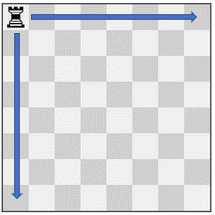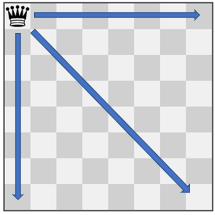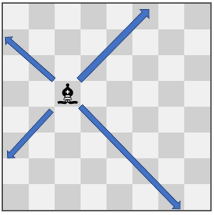Number of Valid Move Combinations On Chessboard
HardThere is an 8 x 8 chessboard containing n pieces (rooks, queens, or bishops). You are given a string array pieces of length n, where pieces[i] describes the type (rook, queen, or bishop) of the ith piece. In addition, you are given a 2D integer array positions also of length n, where positions[i] = [ri, ci] indicates that the ith piece is currently at the 1-based coordinate (ri, ci) on the chessboard.
When making a move for a piece, you choose a destination square that the piece will travel toward and stop on.
- A rook can only travel horizontally or vertically from
(r, c)to the direction of(r+1, c),(r-1, c),(r, c+1), or(r, c-1). - A queen can only travel horizontally, vertically, or diagonally from
(r, c)to the direction of(r+1, c),(r-1, c),(r, c+1),(r, c-1),(r+1, c+1),(r+1, c-1),(r-1, c+1),(r-1, c-1). - A bishop can only travel diagonally from
(r, c)to the direction of(r+1, c+1),(r+1, c-1),(r-1, c+1),(r-1, c-1).
You must make a move for every piece on the board simultaneously. A move combination consists of all the moves performed on all the given pieces. Every second, each piece will instantaneously travel one square towards their destination if they are not already at it. All pieces start traveling at the 0th second. A move combination is invalid if, at a given time, two or more pieces occupy the same square.
Return the number of valid move combinations.
Notes:
- No two pieces will start in the same square.
- You may choose the square a piece is already on as its destination.
- If two pieces are directly adjacent to each other, it is valid for them to move past each other and swap positions in one second.
Example 1:

Input: pieces = ["rook"], positions = [[1,1]] Output: 15 Explanation: The image above shows the possible squares the piece can move to.
Example 2:

Input: pieces = ["queen"], positions = [[1,1]] Output: 22 Explanation: The image above shows the possible squares the piece can move to.
Example 3:

Input: pieces = ["bishop"], positions = [[4,3]] Output: 12 Explanation: The image above shows the possible squares the piece can move to.
Constraints:
n == pieces.lengthn == positions.length1 <= n <= 4piecesonly contains the strings"rook","queen", and"bishop".- There will be at most one queen on the chessboard.
1 <= ri, ci <= 8- Each
positions[i]is distinct.
Solution
Clarifying Questions
When you get asked this question in a real-life environment, it will often be ambiguous (especially at FAANG). Make sure to ask these questions in that case:
- What are the maximum values for 'n' (chessboard size), the number of pieces, and the length of each move sequence?
- Can a piece stay in the same cell for multiple moves in its sequence, and if so, is that still considered a valid move?
- If no valid combinations exist, what should the function return (e.g., 0, -1, null)?
- Are the initial positions of the pieces guaranteed to be unique, or can multiple pieces start in the same cell?
- Are the moves in a move sequence relative (e.g., 'up', 'down', 'left', 'right') or absolute coordinates on the board?
Brute Force Solution
Approach
The core idea is to explore every possible sequence of moves for each piece. We will simulate all combinations of moves until a solution is found or all possibilities are exhausted. It's like trying every combination lock until you find the correct one.
Here's how the algorithm would work step-by-step:
- Consider each piece on the chessboard one by one.
- For each piece, determine all possible single moves it can make based on the chessboard rules.
- Combine these single moves to form sequences of moves for each piece.
- Try out all possible combinations of move sequences for all the pieces.
- For each complete combination of move sequences, check if the combination is valid by ensuring pieces do not collide or end up in the same spot at the same time.
- If a combination is valid, increment the count of valid combinations.
- Repeat this process until all possible combinations of move sequences have been explored.
- The total count of valid combinations found is the answer.
Code Implementation
def find_valid_move_combinations_brute_force(pieces, board_size):
number_of_pieces = len(pieces)
valid_combinations_count = 0
def is_valid_move(move):
# Placeholder: Replace with actual move validation logic
# For simplicity, always return True
return True
def is_valid_combination(moves):
# Placeholder: Replace with actual combination validation logic
# For simplicity, always return True
return True
def generate_moves(current_piece_index, current_moves):
nonlocal valid_combinations_count
# If all pieces have moved, check if the combination is valid.
if current_piece_index == number_of_pieces:
if is_valid_combination(current_moves):
valid_combinations_count += 1
return
piece = pieces[current_piece_index]
# Iterate through possible moves for the current piece.
for row in range(board_size):
for col in range(board_size):
move = (piece, (row, col))
# Check if the current move is valid.
if is_valid_move(move):
generate_moves(current_piece_index + 1, current_moves + [move])
# Start the recursive move generation from the first piece.
generate_moves(0, [])
return valid_combinations_countBig(O) Analysis
Optimal Solution
Approach
The problem involves figuring out how chess pieces can move without blocking each other. The optimal approach is to view the chessboard and pieces as a graph and uses graph traversal to systematically explore possible move combinations. This avoids redundant calculations, significantly speeding up the process.
Here's how the algorithm would work step-by-step:
- Represent the chessboard as a graph where each square is a point and possible moves between squares are connections.
- Consider each chess piece and how it can move based on the type of piece.
- Try all possible paths for the first piece, marking which squares are occupied as the piece moves.
- For each path of the first piece, try all possible paths for the second piece, keeping in mind squares now blocked by the first piece.
- Continue this process for each chess piece. If a piece can't move without collision on the board or another piece, that branch of possibilities is abandoned.
- Keep track of successful combinations that don't have any collisions.
- Finally, count all of these valid combinations to get the answer.
Code Implementation
def number_of_valid_move_combinations_on_chessboard(piece_positions, piece_moves):
number_of_pieces = len(piece_positions)
adjacency_list = [[] for _ in range(number_of_pieces)]
for first_piece_index in range(number_of_pieces):
for second_piece_index in range(first_piece_index + 1, number_of_pieces):
adjacency_list[first_piece_index].append(second_piece_index)
adjacency_list[second_piece_index].append(first_piece_index)
number_of_moves = [len(moves) for moves in piece_moves]
total_move_combinations = 1
for move_count in number_of_moves:
total_move_combinations *= move_count
move_combinations_count = 0
#Use a cache to avoid duplicate work
cache = {}
def depth_first_search(piece_index, current_moves):
nonlocal move_combinations_count
if piece_index == number_of_pieces:
move_combinations_count += 1
return
cache_key = tuple(current_moves)
if cache_key in cache:
move_combinations_count += cache[cache_key]
return
valid_combinations_from_here = 0
for move_index in range(number_of_moves[piece_index]):
is_valid_move = True
for previous_piece_index in range(piece_index):
#Check for collision with previous moves
if (current_moves[previous_piece_index] == move_index and
adjacency_list[piece_index] and previous_piece_index in adjacency_list[piece_index]):
is_valid_move = False
break
if is_valid_move:
current_moves[piece_index] = move_index
depth_first_search(piece_index + 1, current_moves)
cache[cache_key] = valid_combinations_from_here
# Start the depth first search exploration
depth_first_search(0, [0] * number_of_pieces)
# Return the number of valid combinations found
return move_combinations_countBig(O) Analysis
Edge Cases
| Case | How to Handle |
|---|---|
| Null or empty positions array | Return 1, indicating one valid combination (doing nothing). |
| Null or empty move sequences array | Return 1, indicating one valid combination (doing nothing for that piece). |
| Chessboard size of 1x1 | Check for immediate collisions if any moves are made. |
| Single piece on the board | Return the number of valid move sequences for that piece. |
| Maximum board size and maximum number of pieces to test scalability. | Optimize the collision detection to avoid excessive time complexity with a large board. |
| Pieces starting in the same location | The algorithm must account for immediate collisions if pieces start on the same square. |
| Move sequences that result in the pieces leaving the board. | Treat out-of-bounds moves as invalid and reject that particular move sequence. |
| Very long move sequences for some or all pieces. | Consider memory limits during recursive or iterative processing of move sequences to prevent stack overflow or OOM errors. |